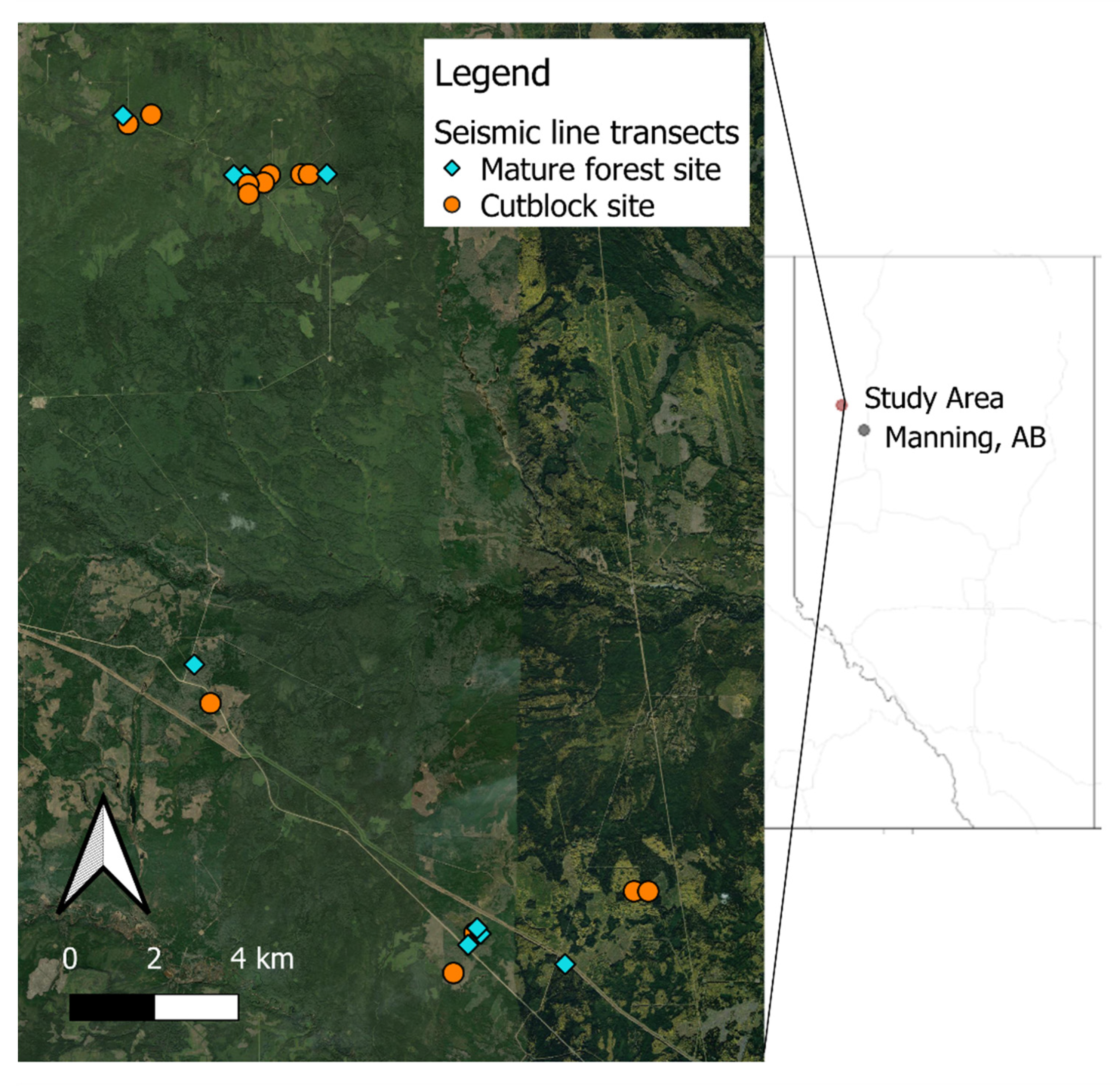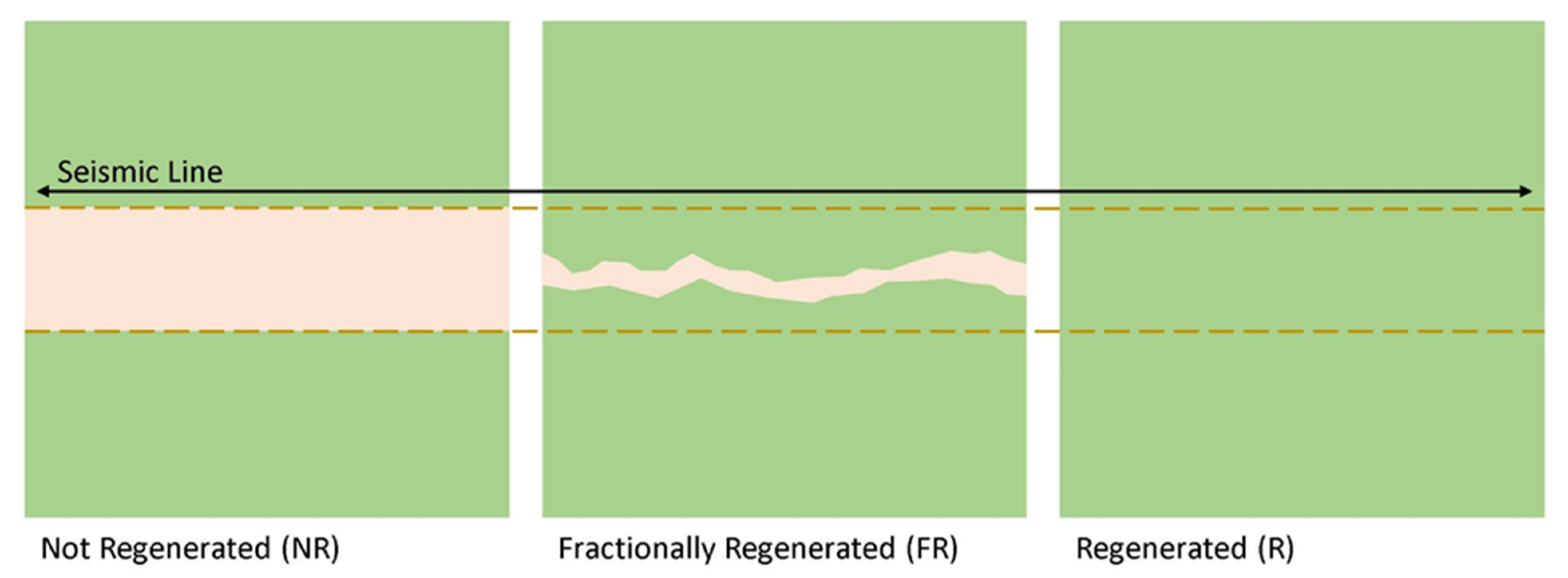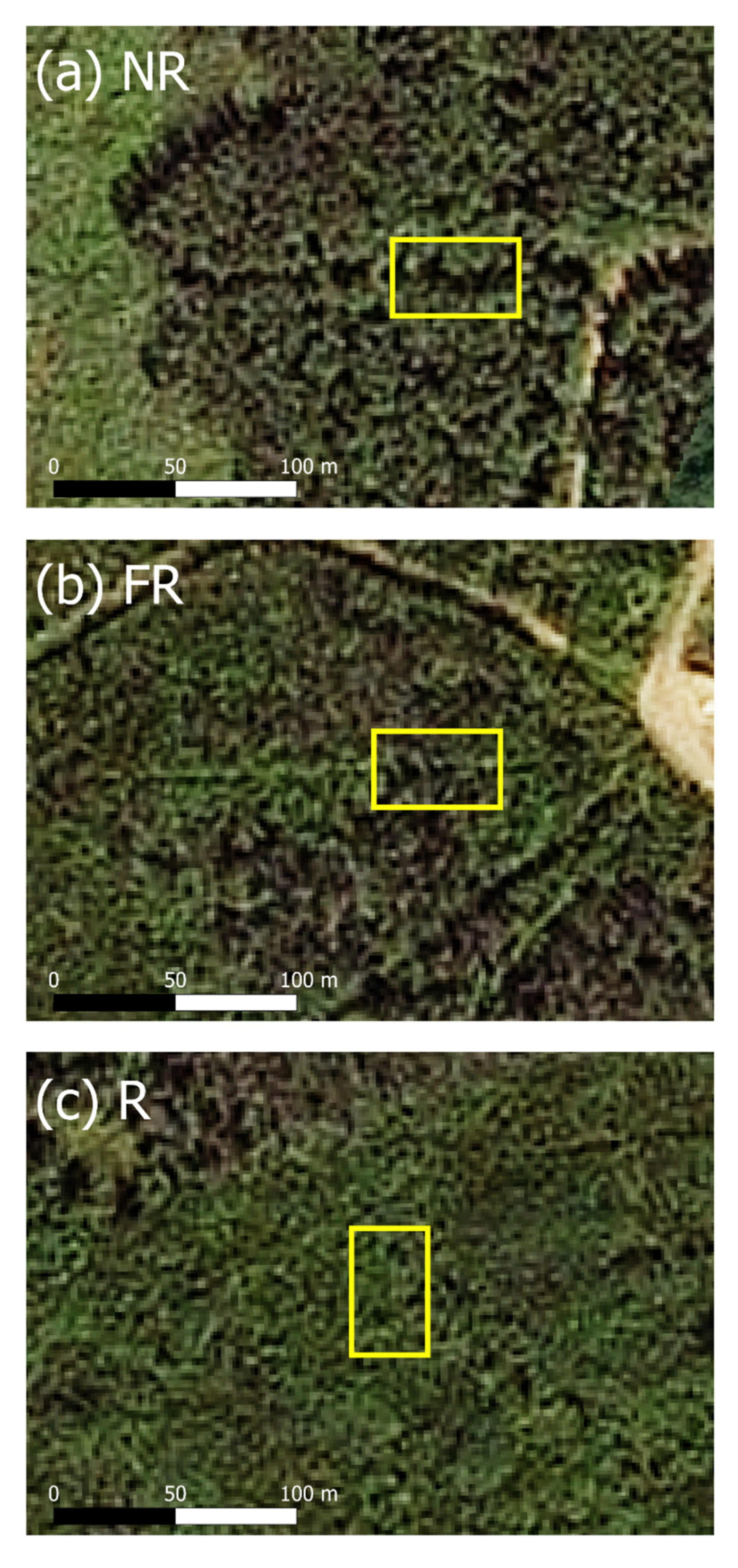Ground Validation of Seismic Line Forest Regeneration Assessments Based on Visual Interpretation of Satellite Imagery
Abstract
:1. Introduction
2. Materials and Methods
2.1. Study Area
2.2. Classification of Recovery Using Satellite Imagery
2.3. Ground Validation
2.4. Recovery Criteria
2.5. Data Analysis
3. Results
3.1. Tree and Shrub Composition
3.2. Comparing Transect Data with Recovery Criteria
3.3. Comparing Response Variables between Classification Categories
4. Discussion
4.1. Accuracy of Classification Categories
4.2. Recovered Seismic Lines in Mature Forests
4.3. Limitations
5. Conclusions
Author Contributions
Funding
Data Availability Statement
Acknowledgments
Conflicts of Interest
Appendix A
| Transect Number | Classification | Number of Trees | % Coniferous | % Deciduous |
|---|---|---|---|---|
| 1 | NR | 40 | 38 | 63 |
| 2 | NR | 23 | 13 | 87 |
| 3 | NR | 15 | 67 | 33 |
| 4 | NR | 20 | 70 | 30 |
| 5 | NR | 37 | 89 | 11 |
| 6 | NR | 9 | 56 | 44 |
| 7 | FR | 39 | 51 | 49 |
| 8 | FR | 63 | 41 | 59 |
| 9 | FR | 167 | 7 | 93 |
| 10 | FR | 31 | 13 | 87 |
| 11 | FR | 152 | 7 | 93 |
| 12 | FR | 119 | 71 | 29 |
| 13 | FR | 188 | 34 | 66 |
| 14 | FR | 140 | 61 | 39 |
| 15 | FR | 12 | 92 | 8 |
| 16 | FR | 44 | 16 | 84 |
| 17 | R | 49 | 65 | 35 |
| 18 | R | 65 | 28 | 72 |
| 19 | R | 112 | 61 | 39 |
| 20 | R | 57 | 32 | 68 |
| 21 | R | 156 | 15 | 85 |
| 22 | R | 74 | 24 | 76 |
References
- Alberta Environment and Parks. The Alberta Human Footpring Monitoring Program: A Historical Overview of Geophysical Explotation in Alberta; Alberta Environment and Parks: Calgary, AB, Canada, 2021. [Google Scholar]
- Dabros, A.; Pyper, M.; Castilla, G. Seismic Lines in the Boreal and Arctic Ecosystems of North America: Environmental Impacts, Challenges, and Opportunities. Environ. Rev. 2018, 26, 214–229. [Google Scholar] [CrossRef] [Green Version]
- Timoney, K.; Lee, P. Environmental Management in Resource-Rich Alberta, Canada: First World Jurisdiction, Third World Analogue? J. Environ. Manag. 2001, 63, 387–405. [Google Scholar] [CrossRef] [PubMed]
- Lee, P.; Boutin, S. Persistence and Developmental Transition of Wide Seismic Lines in the Western Boreal Plains of Canada. J. Environ. Manag. 2006, 78, 240–250. [Google Scholar] [CrossRef] [PubMed]
- Van Rensen, C.K.; Nielsen, S.E.; White, B.; Vinge, T.; Lieffers, V.J. Natural Regeneration of Forest Vegetation on Legacy Seismic Lines in Boreal Habitats in Alberta’s Oil Sands Region. Biol. Conserv. 2015, 184, 127–135. [Google Scholar] [CrossRef] [Green Version]
- Filicetti, A.T.; Cody, M.; Nielsen, S.E. Caribou Conservation: Restoring Trees on Seismic Lines in Alberta, Canada. Forests 2019, 10, 185. [Google Scholar] [CrossRef] [Green Version]
- Pyper, M.; Nishi, J.; McNeil, L. Linear Feature Restoration in Caribou Habitat: A Summary of Current Practices and a Roadmap for Future Programs; Canada’s Oil Sands Innovation Alliance: Calgary, AB, Canada, 2014. [Google Scholar]
- Alberta Biodiversity Monitoring Institute. Prioritizing Zones for Caribou Habitat Restoration in the Canada’s Oil Sands Innovation Alliance Area; Alberta Biodiversity Monitoring Institute: Edmonton, AB, Canada, 2016. [Google Scholar]
- Chen, S.; McDermid, G.J.; Castilla, G.; Linke, J. Measuring Vegetation Height in Linear Disturbances in the Boreal Forest with UAV Photogrammetry. Remote Sens. 2017, 9, 1257. [Google Scholar] [CrossRef] [Green Version]
- Abib, T.H.; Chasmer, L.; Hopkinson, C.; Mahoney, C.; Rodriguez, L.C.E. Seismic Line Impacts on Proximal Boreal Forest and Wetland Environments in Alberta. Sci. Total Environ. 2019, 658, 1601–1613. [Google Scholar] [CrossRef] [PubMed]
- Barber, Q.E.; Bater, C.W.; Dabros, A.; Pinzon, J.; Nielsen, S.E.; Parisien, M.-A. Persistent Impact of Conventional Seismic Lines on Boreal Vegetation Structure Following Wildfire. Can. J. For. Res. 2021, 51, 1581–1594. [Google Scholar] [CrossRef]
- Alberta Biodiversity Monitoring Institute. Collaborative Landscape Data to Support Woodland Caribou Recovery Planning in Northwestern Alberta; Alberta Biodiversity Monitoring Institute: Edmonton, AB, Canada, 2021. [Google Scholar]
- White, J.C.; Saarinen, N.; Kankare, V.; Wulder, M.A.; Hermosilla, T.; Coops, N.C.; Pickell, P.D.; Holopainen, M.; Hyyppä, J.; Vastaranta, M. Confirmation of Post-Harvest Spectral Recovery from Landsat Time Series Using Measures of Forest Cover and Height Derived from Airborne Laser Scanning Data. Remote Sens. Environ. 2018, 216, 262–275. [Google Scholar] [CrossRef]
- Fromm, M.; Schubert, M.; Castilla, G.; Linke, J.; McDermid, G. Automated Detection of Conifer Seedlings in Drone Imagery Using Convolutional Neural Networks. Remote Sens. 2019, 11, 2585. [Google Scholar] [CrossRef] [Green Version]
- He, Y.; Franklin, S.E.; Guo, X. Narrow-Linear and Small-Area Forest Disturbance Detection and Mapping from High Spatial Resolution Imagery: A Framework. J. Appl. Remote Sens. 2009, 3, 033570. [Google Scholar] [CrossRef]
- QGIS Development Team. QGIS Geographic Information System, 2020. Open Source Geospatial Foundation Project. Available online: http://qgis.osgeo.org (accessed on 20 November 2020).
- Willoughby, M.G.; Downing, D.J.; Meijer, M. Guide to Ecological Sites of the Lower Boreal Highlands Subregion; Alberta Environment and Parks: Edmonton, AB, Canada, 2016; ISBN 9781460131695. [Google Scholar]
- Natural Regions Committee. Natural Regions and Subregions of Alberta; Natural Regions Committee: Edmonton, AB, Canada, 2006. [Google Scholar]
- Environment and Climate Change Canada. Canadian Climate Normals 1981–2010 Station Data—Manning. Available online: https://climate.weather.gc.ca/climate_normals/results_1981_2010_e.html?searchType=stnProv&lstProvince=AB&txtCentralLatMin=0&txtCentralLatSec=0&txtCentralLongMin=0&txtCentralLongSec=0&stnID=2750&dispBack=0 (accessed on 17 January 2021).
- Government of Alberta. Forest Management Agreement Boundaries [Map]. Available online: https://open.alberta.ca/publications/forest-management-agreement-boundaries-map#detailed (accessed on 13 December 2021).
- Pulse Seismic Inc. Pulse Seismic Data Map. Available online: https://map.pulseseismic.com/main.html (accessed on 9 November 2021).
- Alberta Biodiversity Monitoring Institute. Wall-to-Wall Human Footprint Inventory. Available online: https://abmi.ca/home/data-analytics/da-top/da-product-overview/Human-Footprint-Products/HF-inventory.html (accessed on 9 November 2021).
- Alberta Agriculture and Forestry. Derived Ecosite Phase v2.0. Available online: https://gda.alberta.ca/geoportal/rest/metadata/item/c76ad555f7f743cd9f6dd0d049aaf6b8/html (accessed on 9 November 2021).
- Dabros, A.; James Hammond, H.E.; Pinzon, J.; Pinno, B.; Langor, D. Edge Influence of Low-Impact Seismic Lines for Oil Exploration on Upland Forest Vegetation in Northern Alberta (Canada). For. Ecol. Manag. 2017, 400, 278–288. [Google Scholar] [CrossRef]
- Harper, K.A.; Macdonald, S.E.; Mayerhofer, M.S.; Biswas, S.R.; Esseen, P.A.; Hylander, K.; Stewart, K.J.; Mallik, A.U.; Drapeau, P.; Jonsson, B.G.; et al. Edge Influence on Vegetation at Natural and Anthropogenic Edges of Boreal Forests in Canada and Fennoscandia. J. Ecol. 2015, 103, 550–562. [Google Scholar] [CrossRef]
- Esri Inc ArcGIS Pro (Version 2.5). 2020. Available online: http://www.esri.com/en-us/arcgis/products-pro/overvoew (accessed on 20 November 2020).
- Government of Alberta. 2010 Reclamation Criteria for Wellsites and Associated Facilities for Forested Lands; Government of Alberta: Edmonton, AB, Canada, 2013.
- Pinheiro, J.; Bates, D.; DebRoy, S.; Sarkar, D.; R Core Team. nlme: Linear and Nonlinear Mixed Effects Models. 2020. Available online: https://CRAN.R-project.org/package=nlme (accessed on 20 November 2020).
- R Core Team. R: A Language and Environment for Statistical Computing; R Foundation for Statistical Computing: Vienna, Austria, 2020; Available online: http://www.R-project.org (accessed on 20 November 2020).
- Svatonova, H. Analysis of Visual Interpretation of Satellite Data. Int. Arch. Photogramm. Remote Sens. Spat. Inf. Sci. 2016, 41, 675–681. [Google Scholar] [CrossRef] [Green Version]
- Asrat, Z.; Taddese, H.; Ørka, H.O.; Gobakken, T.; Burud, I.; Næsset, E. Estimation of Forest Area and Canopy Cover Based on Visual Interpretation of Satellite Images in Ethiopia. Land 2018, 7, 92. [Google Scholar] [CrossRef] [Green Version]
- Holopainen, M.; Vastaranta, M.; Karjalainen, M.; Karila, K.; Kaasalainen, S.; Honkavaara, E.; Hyyppä, J. Forest Inventory Attribute Estimation Using Airborne Laser Scanning, Aerial Stereo Imagery, Radargrammetry and Interferometry-Finnish Experiences of the 3d Techniques. ISPRS Ann. Photogramm. Remote Sens. Spat. Inf. Sci. 2015, 2, 63–69. [Google Scholar] [CrossRef] [Green Version]
- Bayne, E.; Lankau, H.; Tigner, J. Ecologically-Based Criteria to Assess the Impact and Recovery of Seismic Lines: The Importance of Width, Regeneration, and Seismic Density; Environmental Studies Research Funds: Ottawa, ON, Canada, 2011. [Google Scholar]






| Transect Number | Classification | Location | Latitude | Longitude |
|---|---|---|---|---|
| 1 | NR | Cutblock | 57.23495 | −118.22692 |
| 2 | NR | Cutblock | 57.23493 | −118.22127 |
| 3 | NR | Forest | 57.38724 | −118.34757 |
| 4 | NR | Forest | 57.28310 | −118.39974 |
| 5 | NR | Forest | 57.22357 | −118.29211 |
| 6 | NR | Forest | 57.22713 | −118.28856 |
| 7 | FR | Cutblock | 57.38718 | −118.35775 |
| 8 | FR | Cutblock | 57.38502 | −118.37852 |
| 9 | FR | Cutblock | 57.27486 | −118.39337 |
| 10 | FR | Cutblock | 57.21760 | −118.29787 |
| 11 | FR | Cutblock | 57.38302 | −118.37844 |
| 12 | FR | Forest | 57.38699 | −118.42777 |
| 13 | FR | Forest | 57.39967 | −118.42777 |
| 14 | FR | Forest | 57.38703 | −118.38419 |
| 15 | FR | Forest | 57.22595 | −118.28721 |
| 16 | FR | Forest | 57.21947 | −118.25399 |
| 17 | R | Cutblock | 57.38719 | −118.35468 |
| 18 | R | Cutblock | 57.38708 | −118.37003 |
| 19 | R | Cutblock | 57.38541 | −118.37241 |
| 20 | R | Cutblock | 57.39985 | −118.41661 |
| 21 | R | Cutblock | 57.39784 | −118.42574 |
| 22 | R | Cutblock | 57.22610 | −118.28963 |
Publisher’s Note: MDPI stays neutral with regard to jurisdictional claims in published maps and institutional affiliations. |
© 2022 by the authors. Licensee MDPI, Basel, Switzerland. This article is an open access article distributed under the terms and conditions of the Creative Commons Attribution (CC BY) license (https://creativecommons.org/licenses/by/4.0/).
Share and Cite
Van Dongen, A.; Jones, C.; Doucet, C.; Floreani, T.; Schoonmaker, A.; Harvey, J.; Degenhardt, D. Ground Validation of Seismic Line Forest Regeneration Assessments Based on Visual Interpretation of Satellite Imagery. Forests 2022, 13, 1022. https://doi.org/10.3390/f13071022
Van Dongen A, Jones C, Doucet C, Floreani T, Schoonmaker A, Harvey J, Degenhardt D. Ground Validation of Seismic Line Forest Regeneration Assessments Based on Visual Interpretation of Satellite Imagery. Forests. 2022; 13(7):1022. https://doi.org/10.3390/f13071022
Chicago/Turabian StyleVan Dongen, Angeline, Caren Jones, Casey Doucet, Trevor Floreani, Amanda Schoonmaker, Jill Harvey, and Dani Degenhardt. 2022. "Ground Validation of Seismic Line Forest Regeneration Assessments Based on Visual Interpretation of Satellite Imagery" Forests 13, no. 7: 1022. https://doi.org/10.3390/f13071022
APA StyleVan Dongen, A., Jones, C., Doucet, C., Floreani, T., Schoonmaker, A., Harvey, J., & Degenhardt, D. (2022). Ground Validation of Seismic Line Forest Regeneration Assessments Based on Visual Interpretation of Satellite Imagery. Forests, 13(7), 1022. https://doi.org/10.3390/f13071022






